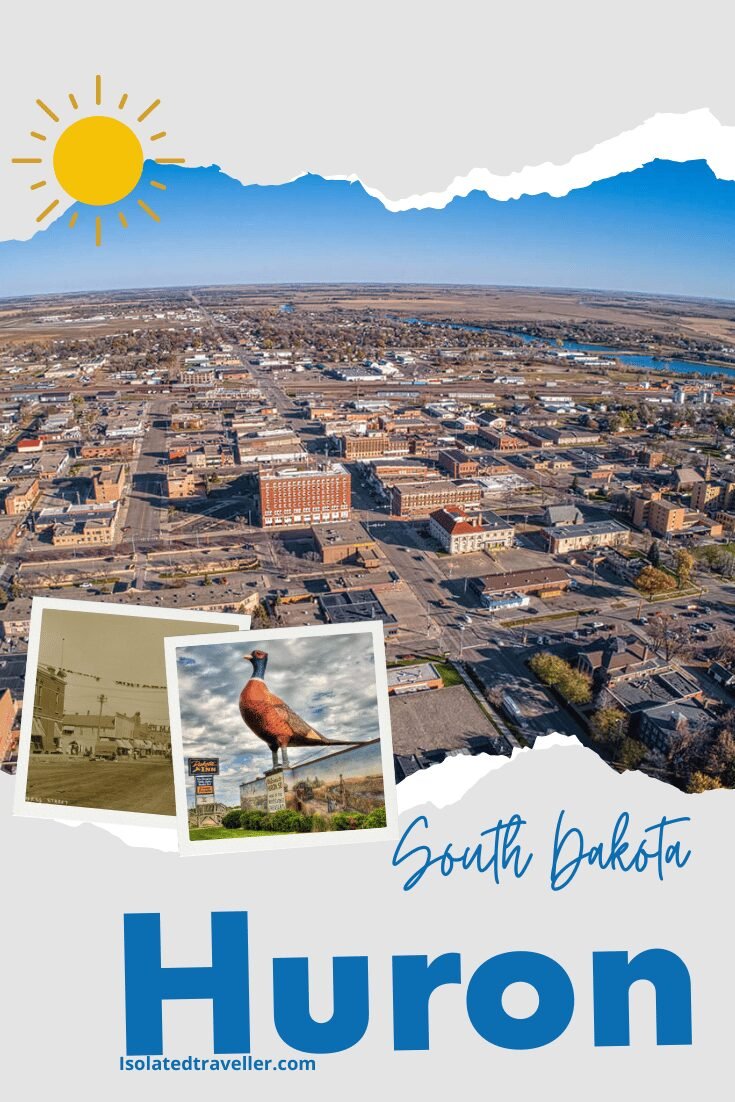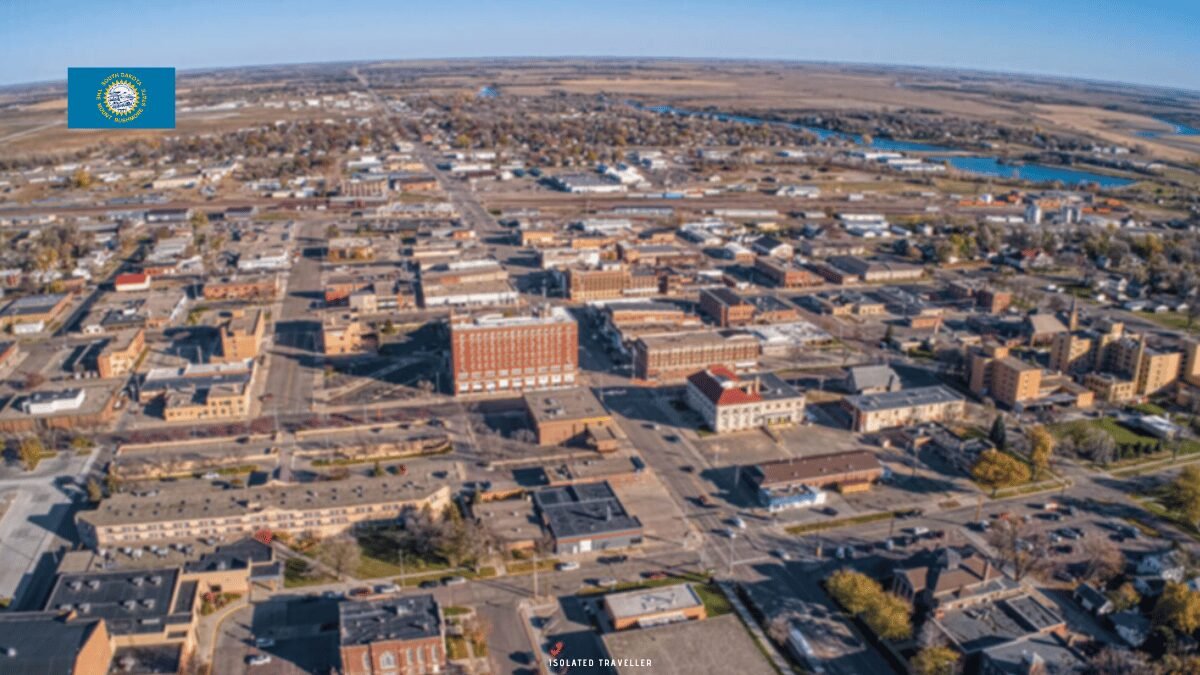Huron, South Dakota
Huron is a city located in the state of South Dakota, United States. The city is the county seat of Beadle County, and it is the ninth-largest city in the state. Huron was founded in 1880 and was named after the Huron Indians, a tribe of Native Americans that once lived in the area. The city is located in the James River Valley, known for its fertile farmland and rich history.
The city has a population of around 13,000 people. Agriculture is a major part of the local economy, with a focus on crops such as corn, soybeans, wheat, and sunflowers. The city also has a growing meat processing industry. Huron is home to the South Dakota State Fair, which is held annually and draws visitors from all over the region.
Huron is a regional centre for higher education, with Huron University, a four-year liberal arts college, and Huron Regional Medical Center School of Nursing. The city also has a major regional hospital, Joe Foss Field Regional Airport, multiple museums showcasing the history of Huron, and a strong community spirit, with many events and festivals taking place throughout the year.
Geography Of Huron
Huron is located in the James River Valley in the east-central part of South Dakota. The city is situated at the intersection of U.S. Highway 14 and U.S. Highway 37, which provides easy access to other parts of the state.
The city is situated on the James River, which is a tributary of the Missouri River, and the Huron wetlands are located on the southern edge of the city. The city also has a small lake, the North Huron Lake, located on the north side of the city.
The surrounding area is mostly flat with a few rolling hills and is known for its fertile farmland. The area is ideal for agriculture and the main crops grown are corn, soybeans, wheat, and sunflowers. The soil is rich in nutrients, and the climate is favourable for growing crops, with warm summers and cold winters.
Huron also boasts a nearby natural landmark, which is the Big Stone Lake, and Big Stone City, which are both located a few miles west of Huron. The lake and city are situated on the Minnesota-South Dakota border and are the largest natural lakes in the eastern part of South Dakota, and one of the most popular tourist destinations in the area.
Additionally, Huron’s proximity to other cities such as Mitchell, Watertown, and Sioux Falls makes it a central hub for travellers and tourists.
Huron Economy
The economy of Huron, South Dakota, is primarily based on agriculture and related industries. The fertile soil and favourable climate in the James River Valley make the area ideal for growing crops such as corn, soybeans, wheat, and sunflowers. These crops are grown on the vast stretches of agricultural land surrounding the city, and they provide the foundation for the local agricultural economy.
The city is also home to several major meat processing plants, such as Dakota Provisions, which employ a significant number of people in the area and have a big impact on the local economy.
Additionally, the city has a growing manufacturing sector, which includes companies that produce a variety of products such as farm equipment, automotive parts, and medical devices.
Huron is also a regional centre for healthcare, retail, education and government services which gives it more stability and further diversifies the economy.
The city’s location at the intersection of U.S. Highway 14 and U.S. Highway 37 makes it a convenient hub for transportation and shipping, and Joe Foss Field Regional Airport provides easy access to other parts of the state and the country.
The South Dakota State Fair, held annually in Huron, is also a significant boost to the local economy, as it brings in many visitors and generates revenue for local businesses. Overall, the economy of Huron is stable, and it continues to grow and evolve to meet the changing needs of the community.
Climate Of Huron
Huron, South Dakota, has a humid continental climate, with four distinct seasons. The city has warm summers and cold winters, with temperatures ranging from mild to severe depending on the season.
In the summer, the average high temperature is around 85-90°F (29-32°C), and the average low temperature is around 60-65°F (15-18°C). Summertime also tends to be quite humid, with high levels of moisture in the air.
During the winter, the average high temperature is around 20-25°F (-6 to -4°C), and the average low temperature is around 0-5°F (-18 to -15°C). Snowfall is common in the winter, and the city can receive up to 2-3 feet (61-91 cm) of snow each year.
The spring and fall seasons are milder, with temperatures ranging from cool to mild. The spring season is usually dry, but the fall season tends to be wetter, with occasional rain and storms.
Huron’s location in the James River Valley area of South Dakota can have temperature and weather variations compared to other regions of the state. The valley’s topography can shelter the city from harsh weather conditions.
Overall, the climate in Huron is typical for a Midwestern city and can be challenging during extreme weather conditions but overall is pleasant. It’s a good mix of warm summers and cold winters, but with all 4 seasons clearly defined.
History Of Huron

Huron, South Dakota, has a rich history that dates back to the late 19th century. The city was founded in 1880 when the Chicago & North Western Railway built a line through the James River Valley. The railway company established a station at the location that would eventually become Huron, and the city was named after the Huron Indians, a tribe of Native Americans that once lived in the area.
In 1882, Beadle County was established, and Huron was designated as the county seat. This sparked rapid growth in the city’s population, as people moved to the area to take advantage of the new opportunities that the railway and the county government brought.
The early years of the city were marked by rapid growth and expansion. The first businesses and homes were built, and the city quickly developed into a bustling hub of activity. Agriculture was an important part of the local economy from the early days, and the fertile soil and favourable climate in the James River Valley made the area ideal for growing crops such as corn, soybeans, wheat, and sunflowers.
Huron’s population continued to grow throughout the early 20th century, and the city began to develop new industries and services to meet the needs of its citizens. The regional hospital and a regional airport were built, and new schools and businesses were established.
As the city grew, it also attracted more and more visitors, who came to see the South Dakota State Fair, held annually in Huron. Today, the fair remains an important part of the city’s history and continues to bring in many visitors each year.
Overall, the history of Huron is the story of a small, rural town that grew and prospered to become a vital part of the state’s economy and culture. The city has seen many changes over the years, but it has always been a resilient and hardworking community, proud of its roots and excited about its future.
Huron and nearby Attractions
Huron, South Dakota, is home to a variety of interesting attractions for visitors to explore. Here are a few nearby places to check out:
- The South Dakota State Fair: The fair is held annually in Huron and features a wide variety of entertainment, including concerts, carnival rides, and agricultural competitions.
- The Dakota Discovery Museum: This museum is located in downtown Huron and offers exhibits showcasing the history and culture of the Dakota Territory, including Native American artefacts, pioneer and homesteader memorabilia, and displays of local wildlife.
- Big Stone Lake: This lake is located a few miles west of Huron, on the Minnesota-South Dakota border, and is one of the most popular tourist destinations in the area. Big Stone Lake offers many recreational opportunities such as fishing, boating and more.
- The Beadle County Historical Society Museum: This museum is located on the outskirts of Huron, and it displays a variety of historical artefacts, photographs and artefacts related to the history of Beadle County.
- The Huron Wetlands: The wetlands are located on the southern edge of the city and are home to a variety of wildlife, including migratory birds, waterfowl, and small mammals.
- Joe Foss Field Regional Airport: This airport is located in Huron and it serves as a hub for air travel in the region, with regular flights to major cities in the Midwest.
- The James River Valley: The valley is known for its beautiful scenery and outdoor recreational opportunities, such as hiking, fishing, and camping.
- Watertown and Mitchell: Both are nearby cities to Huron, with a lot to offer, such as historical attractions, shopping and dining experiences.
Overall, the Huron area offers a wide range of activities and attractions for visitors to enjoy, from exploring the city’s rich history and cultural heritage to experiencing the natural beauty of the James River Valley and Big Stone Lake.
Related Articles


